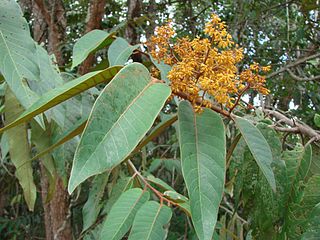
Virola is a genus of flowering plants in the nutmeg family, Myristicaceae. It includes medium-sized trees native to rainforests of the tropical Americas, ranging from southern Mexico to Bolivia and southern Brazil. Species are known commonly as epená, patricá, or cumala. They have glossy, dark green leaves and clusters of tiny yellow flowers, and may emit a pungent odor.

Corymbia calophylla, commonly known as marri, is a species of flowering plant in the family Myrtaceae and is endemic to the southwest of Western Australia. It is a tree or mallee with rough bark on part or all of the trunk, lance-shaped adult leaves, branched clusters of cup-shaped or pear-shaped flower buds, each branch with three or seven buds, white to pink flowers, and relatively large oval to urn-shaped fruit, colloquially known as honky nuts. Marri wood has had many uses, both for Aboriginal people, and in the construction industry.

Tingo María National Park is located in the districts of Rupa Rupa and Mariano Dámaso, in the region of Huánuco, Peru. It was established on May 14, 1965 and its main attractions are the montane forest vegetation and the cave named Cueva de las Lechuzas where the oilbirds nest. The park has an area of 4,777 hectares (18.44 sq mi) that include a mountain massif called La Bella Durmiente.
Virola parvifolia is a species of plant in the family Myristicaceae. It is endemic to Brazil, Colombia and Venezuela.

Virola surinamensis, known commonly as baboonwood, ucuuba, ucuhuba and chalviande, is a species of flowering plant in the family Myristicaceae. It is found in Brazil, Costa Rica, Ecuador, French Guiana, Guyana, Panama, Peru, Suriname, and Venezuela. It has also been naturalized in the Caribbean. Its natural habitats are subtropical or tropical moist lowland forests, subtropical or tropical swamps, and heavily degraded former forest. Although the species is listed as threatened due to habitat loss by the IUCN, it is a common tree species found throughout Central and South America.

Virola sebifera is a species of tree in the family Myristicaceae, from North and South America.

Virola elongata is a species of tree in the family Myristicaceae. The tree is native to Panama, Guyana, Brazil, Bolivia, Colombia, Ecuador and Peru. It is also found in Suriname. Virola elongata is thin and 7.5–23 m (25–75 ft) tall, sometimes 30 m (98 ft) tall.

Juncus acutus, the spiny rush, sharp rush or sharp-pointed rush, is a flowering plant in the monocot family Juncaceae. It is native to the Americas, Northern and Southern Africa, Western and Southern Europe and West Asia, and is found in a variety of wet habitats, such as bogs, fens, meadows, and salt marshes, and along the edges of ponds and lakes.

Virola carinata is a New World, tropical evergreen tree in the family Myristicaceae that is indigenous to Colombia, Venezuela and Brazil. It grows to a height of about 30m and its fruit is subglobular, 16–20 mm long and 17–19 mm in diameter, found in groups of 4 to 12.
Virola divergens is a species of tree in the family Myristicaceae. It grows to about 25m tall. The fruits are ellipsoidal and subglobular, 18–38 mm long and 16–33 mm in diameter, grouped 4 to 8.
Virola multinervia is a species of tree in the family Myristicaceae. It is found in Colombia, Peru, Ecuador, Venezuela and Brazil. It grows to a height of about 35m. The fruit is ellipsoidal to ovoidal, 26–40 mm long, 19–32 mm in diameter, and is found in groups of 1 to 7.
Virola pavonis is a species of tree in the family Myristicaceae. It is found in Brazil, Colombia, Ecuador, Peru and Venezuela. The tree grows to a height of about 15-30m tall.
Virola peruviana is a species of tree in the family Myristicaceae. It is found in Brazil, Colombia, Ecuador and Peru. It grows to a height of about 35 m (100 ft). The fruit is ellipsoidal, 14–24 mm long and 11–23 mm in diameter, forming groups of about 5 to 15.
Virola venosa is a species of tree in the family Myristicaceae. It is found in Colombia, Venezuela and Brazil. It grows 5–30 m (16–98 ft) tall.

Roystonea regia, commonly known as the Cuban royal palm or Florida royal palm, is a species of palm native to Mexico, the Caribbean, Florida, and parts of Central America. A large and attractive palm, it has been planted throughout the tropics and subtropics as an ornamental tree. Although it is sometimes called R. elata, the conserved name R. regia is now the correct name for the species. The royal palm reaches heights from 15–24 m (50–80 ft) tall. Populations in Cuba and Florida were long seen as separate species, but are now considered a single species.

Xanthorrhoea preissii, known as balga, is a widespread species of perennial monocot in Southwest Australia.
The Cujubim Sustainable Development Reserve is a sustainable development reserve in the state of Amazonas, Brazil.

The Japurá–Solimões–Negro moist forests (NT0132) is an ecoregion of tropical moist broad leaf forest in the Amazon biome.

The Western Ecuador Moist Forests (NT0178), also known as the Pacific Forest of Ecuador, is an ecoregion in the plains and western foothills of the Andes of southern Colombia and Ecuador. At one time this region contained dense forests with highly diverse flora and fauna, and many endemic species. Most of the original habitat has now been destroyed, and the ecoregion is one of the most threatened in the world.











